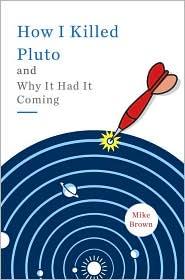
Clyde William Tombaugh was an American astronomer. He discovered Pluto in 1930, the first object to be discovered in what would later be identified as the Kuiper belt. At the time of discovery, Pluto was considered a planet, but was reclassified as a dwarf planet in 2006. Tombaugh also discovered many asteroids, and called for the serious scientific research of unidentified flying objects.
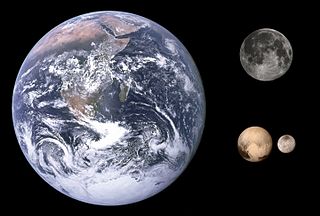
In astronomy, a double planet is a binary satellite system where both objects are planets, or planetary-mass objects, that share an orbital axis external to both planetary bodies.

A planet is a large, rounded astronomical body that is neither a star nor its remnant. The best available theory of planet formation is the nebular hypothesis, which posits that an interstellar cloud collapses out of a nebula to create a young protostar orbited by a protoplanetary disk. Planets grow in this disk by the gradual accumulation of material driven by gravity, a process called accretion. The Solar System has at least eight planets: the terrestrial planets Mercury, Venus, Earth and Mars, and the giant planets Jupiter, Saturn, Uranus and Neptune. These planets each rotate around an axis tilted with respect to its orbital pole. All planets of the Solar System other than Mercury possess a considerable atmosphere, and some share such features as ice caps, seasons, volcanism, hurricanes, tectonics, and even hydrology. Apart from Venus and Mars, the Solar System planets generate magnetic fields, and all except Venus and Mercury have natural satellites. The giant planets bear planetary rings, the most prominent being those of Saturn.

Following the discovery of the planet Neptune in 1846, there was considerable speculation that another planet might exist beyond its orbit. The search began in the mid-19th century and continued at the start of the 20th with Percival Lowell's quest for Planet X. Lowell proposed the Planet X hypothesis to explain apparent discrepancies in the orbits of the giant planets, particularly Uranus and Neptune, speculating that the gravity of a large unseen ninth planet could have perturbed Uranus enough to account for the irregularities.

Pluto is a dwarf planet in the Kuiper belt, a ring of bodies beyond the orbit of Neptune. It is the ninth-largest and tenth-most-massive known object to directly orbit the Sun. It is the largest known trans-Neptunian object by volume, by a small margin, but is slightly less massive than Eris. Like other Kuiper belt objects, Pluto is made primarily of ice and rock and is much smaller than the inner planets. Pluto has only one sixth the mass of Earth's moon, and one third its volume.
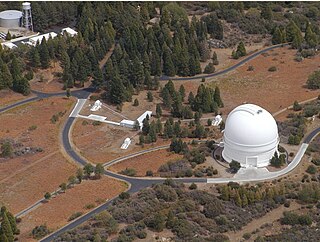
Palomar Observatory is an astronomical research observatory in San Diego County, California, United States, in the Palomar Mountain Range. It is owned and operated by the California Institute of Technology (Caltech). Research time at the observatory is granted to Caltech and its research partners, which include the Jet Propulsion Laboratory (JPL), Yale University, and the National Optical Observatories of China.
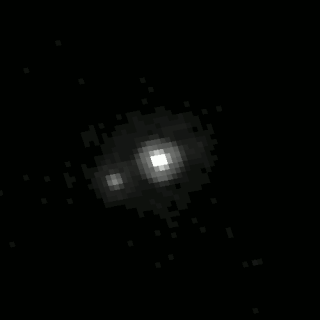
Orcus is a trans-Neptunian dwarf planet with a large moon, Vanth. It has a diameter of 870 to 960 km, the size of or somewhat smaller than the asteroid Ceres. The surface of Orcus is relatively bright with albedo reaching 23 percent, neutral in color and rich in water ice. The ice is predominantly in crystalline form, which may be related to past cryovolcanic activity. Other compounds like methane or ammonia may also be present on its surface. Orcus was discovered by American astronomers Michael Brown, Chad Trujillo, and David Rabinowitz on 17 February 2004.

Sedna is a dwarf planet in the outermost reaches of the Solar System discovered in 2003. Spectroscopy has revealed that Sedna's surface composition is largely a mixture of water, methane, and nitrogen ices with tholins, similar to those of some other trans-Neptunian objects. Its surface is one of the reddest among Solar System objects. Sedna, within estimated uncertainties, is tied with Ceres as the largest planetoid not known to have a moon. It has a diameter of approximately 1,000 km, with an unknown mass.

Michael E. Brown is an American astronomer, who has been professor of planetary astronomy at the California Institute of Technology (Caltech) since 2003. His team has discovered many trans-Neptunian objects (TNOs), including the dwarf planet Eris, which was originally thought to be bigger than Pluto, triggering a debate on the definition of a planet.
The definition of the term planet has changed several times since the word was coined by the ancient Greeks. Greek astronomers employed the term ἀστέρες πλανῆται, 'wandering stars', for star-like objects which apparently moved over the sky. Over the millennia, the term has included a variety of different celestial bodies, from the Sun and the Moon to satellites and asteroids.
Mesoplanets are planetary-mass objects with sizes smaller than Mercury but larger than Ceres. The term was coined by Isaac Asimov. Assuming size is defined in relation to equatorial radius, mesoplanets should be approximately 500 km to 2,500 km in radius.

The Nibiru cataclysm is a supposed disastrous encounter between Earth and a large planetary object that certain groups believed would take place in the early 21st century. Believers in this doomsday event usually refer to this object as Nibiru or Planet X. The idea was first put forward in 1995 by Nancy Lieder, founder of the website ZetaTalk. Lieder claims she is a contactee with the ability to receive messages from extraterrestrials from the Zeta Reticuli star system through an implant in her brain. She states that she was chosen to warn mankind that the object would sweep through the inner Solar System in May 2003 causing Earth to undergo a physical pole shift that would destroy most of humanity.
José Luis Ortiz Moreno is a Spanish astronomer, and former Vicedirector of Technology at the Instituto de Astrofísica de Andalucía (IAA), Spain. He leads a team working on minor planets at the Sierra Nevada Observatory in Granada, Spain. The main-belt asteroid 4436 Ortizmoreno was named in his honor.

Dysnomia (formally (136199) Eris I Dysnomia) is the only known moon of the dwarf planet Eris and is the second-largest known moon of a dwarf planet, after Pluto I Charon. It was discovered in September 2005 by Mike Brown and the Laser Guide Star Adaptive Optics (LGSAO) team at the W. M. Keck Observatory. It carried the provisional designation of S/2005 (2003 UB313) 1 until it was officially named Dysnomia (from the Ancient Greek word Δυσνομία meaning anarchy/lawlessness) in September 2006, after the daughter of the Greek goddess Eris.

A dwarf planet is a small planetary-mass object that is in direct orbit of the Sun, smaller than any of the eight classical planets. The prototypical dwarf planet is Pluto. The interest of dwarf planets to planetary geologists is that they may be geologically active bodies, an expectation that was borne out in 2015 by the Dawn mission to Ceres and the New Horizons mission to Pluto.

The International Astronomical Union (IAU) defined in August 2006 that, in the Solar System, a planet is a celestial body that:
- is in orbit around the Sun,
- has sufficient mass to assume hydrostatic equilibrium, and
- has "cleared the neighbourhood" around its orbit.

Eris is the most massive and second-largest known dwarf planet in the Solar System. It is a trans-Neptunian object (TNO) in the scattered disk and has a high-eccentricity orbit. Eris was discovered in January 2005 by a Palomar Observatory–based team led by Mike Brown and verified later that year. In September 2006, it was named after the Greco–Roman goddess of strife and discord. Eris is the ninth-most massive known object orbiting the Sun and the sixteenth-most massive overall in the Solar System. It is also the largest known object in the solar system that has not been visited by a spacecraft. Eris has been measured at 2,326 ± 12 kilometers (1,445 ± 7 mi) in diameter; its mass is 0.28% that of the Earth and 27% greater than that of Pluto, although Pluto is slightly larger by volume, both having a surface area that is comparable to the area of Russia or Antarctica.
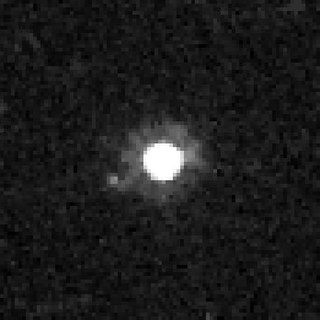
Quaoar (minor-planet designation 50000 Quaoar, provisional designation 2002 LM60) is a dwarf planet in the Kuiper belt, a region of icy planetesimals beyond Neptune. A non-resonant object (cubewano), it measures approximately 1,086 km (675 mi) in diameter, about the size of Saturn's moon Dione or half the size of Pluto. The object was discovered by American astronomers Chad Trujillo and Michael Brown at the Palomar Observatory on 4 June 2002. Signs of water ice on the surface of Quaoar have been found, which suggests that cryovolcanism may be occurring on Quaoar. A small amount of methane is present on its surface, which can only be retained by the largest Kuiper belt objects.
HIP 78530 b is an object that is either a planet or a brown dwarf in the orbit of the star HIP 78530. It was observed as early as 2000, but the object was not confirmed as one in orbit of the star HIP 78530 until a direct imaging project photographed the star in 2008. The image caught the attention of the project's science team, so the team followed up on its initial observations. HIP 78530 b orbits a young, hot, bright blue star in the Upper Scorpius association. The planet itself is over twenty-three times more massive than Jupiter, orbiting eighteen times further from its host star than Pluto does from the Sun by the estimates published in its discovery paper. In this predicted orbit, HIP 78530 b completes an orbit every twelve thousand years.
